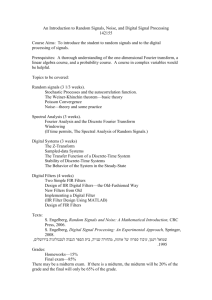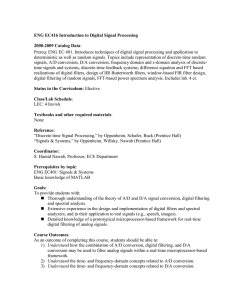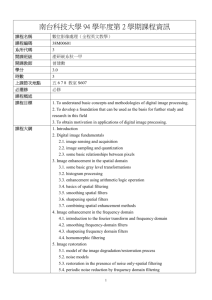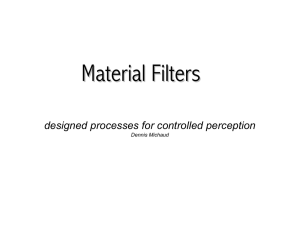SGN-2056 DIGITAL LINEAR FILTERING II • Lecturer: Tapio
advertisement
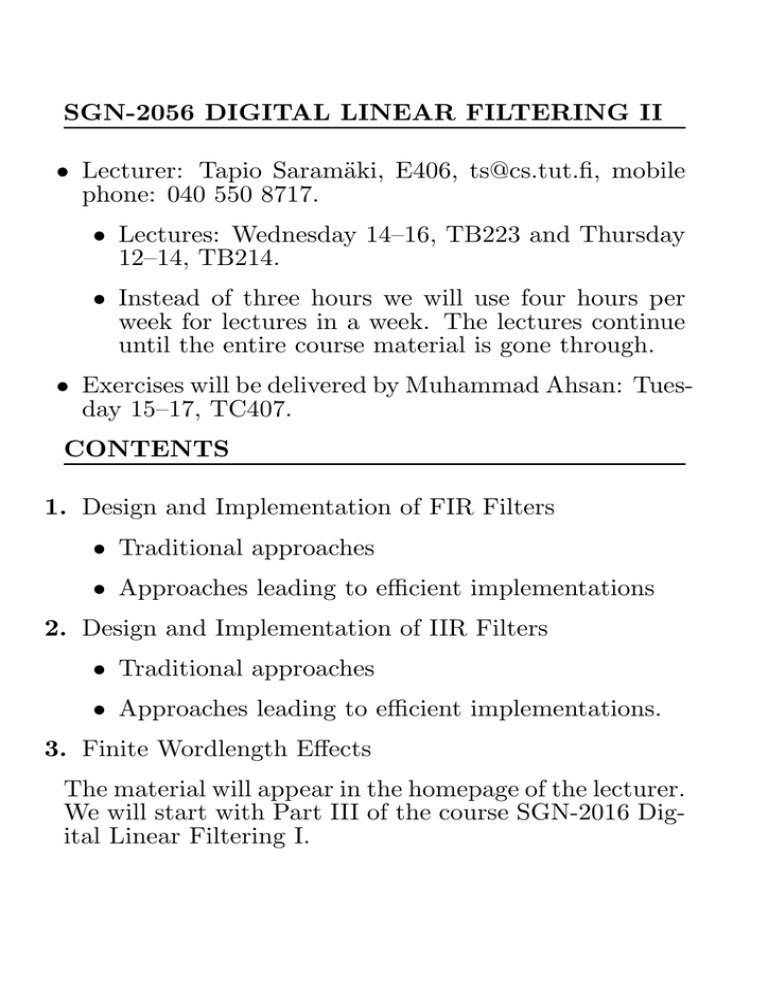
SGN-2056 DIGITAL LINEAR FILTERING II • Lecturer: Tapio Saramäki, E406, ts@cs.tut.fi, mobile phone: 040 550 8717. • Lectures: Wednesday 14–16, TB223 and Thursday 12–14, TB214. • Instead of three hours we will use four hours per week for lectures in a week. The lectures continue until the entire course material is gone through. • Exercises will be delivered by Muhammad Ahsan: Tuesday 15–17, TC407. CONTENTS 1. Design and Implementation of FIR Filters • Traditional approaches • Approaches leading to efficient implementations 2. Design and Implementation of IIR Filters • Traditional approaches • Approaches leading to efficient implementations. 3. Finite Wordlength Effects The material will appear in the homepage of the lecturer. We will start with Part III of the course SGN-2016 Digital Linear Filtering I. HOW TO PASS THE COURSE? • Final examination. • Three homeworks will be given out of which two must be done. For the remaining homework, extra points will be given which are added to the points obtained from the final examination. • There is a mailbox on the fourth floor for returning the homeworks. There is no exact deadline. Without homeworks it is not possible pass the course!! HOW TO BEHAVE DURING THE LECTURE • Let us generate a fruitful and friendly atmosphere such that you are interupting the lecturer by asking ’silly’ or very clever questions!! • Why this? This gives proper guidelines to the lecturer to explain simple matters faster and to focus on matters that are difficult for you. • Send messages (just very important ones) to the e-mail address of the lecturer: ts@cs.tut.fi COURSE MATERIAL • FIR filters: • Lecture notes. • T. Saramäki, ”Finite impulse reponse filter design”, Chapter 4 in Handbook for Digital Signal Processing, edited by S. K. Mitra and J. F. Kaiser, John Wiley and Sons, New York, 1993, pp. 155–277, Sections 4-1 – 4-11 (not 4-12). • T. Saramäki, ”Design of computationally efficient FIR filters using periodic subfilters as building blocks” in The Circuits and Filters Handbook, CRC Press, Inc., 1995, pp. 2578–2601. • IIR filters: • Lecture notes. • Finite wordlength effects: • Lecture notes. DIVISION OF THE COURSE MATERIAL INTO SUBTOPICS • Part I: Basics of Digital Filtering • Part II: Design of FIR Filters • Part III: Design of IIR Filters • Part IV: Finite Wordlength Effects • The following four pages tell what to read on each topic for the examination. SGN-2056 DIGITAL LINEAR FILTERING II Part I: Basics of Digital Filtering • Parts 1 and 2 of the cources SGN-2010: Digitaalinen lineaarinen suodatus I or SGN-2016; Digital Linear Filtering I. • Good to read briefly through in order to get some background. Not considered in the final examination. • Why to go fast through the same material?: A human being is gradually learning difficult topics in a deeper manner when reading or listening the same material once gain. This is based on the earlier feedback from the students. • This year we are not going trough this material because, instead of seven weeks we had last year, we have now only six weeks. This was an old story; this year we have instead of the above-mentioned seven weeks with four hours of lectures, eight weeks with three hours of lectures. Anyway, please read briefly the abovementioned material once again. SGN-2056 DIGITAL LINEAR FILTERING II Part II: Design of FIR Filters • Part 3 of the course SGN-2010 Digitaalinen lineaarinen suodatus I or SGN-2016 Digital Linear Filtering I • A pile of lecture notes on more sophisticated design methods (three sections) • Three appendices on the use of linear programming for FIR filter design • The following book chapters: • T. Saramäki, ”Finite impulse reponse filter design”, Chapter 4 in Handbook for Digital Signal Processing, edited by S. K. Mitra and J. F. Kaiser, John Wiley and Sons, New York, 1993, pp. 155–277, Sections 4-1 – 4-11 (not 4-12). • T. Saramäki, ”Design of computationally efficient FIR filters using periodic subfilters as building blocks” in The Circuits and Filters Handbook, CRC Press, Inc., 1995, pp. 2578–2601. SGN-2056 DIGITAL LINEAR FILTERING II Part III: Design of IIR Filters • Part 4 of the course SGN-2010 Digitaalinen lineaarinen suodatus I or SGN-2016 Digital Linear Filtering I • A pile of lecture notes on the use of allpass filters as well as a short article by Markku Renfors • Note that in the lecture notes of the the course SGN2010 Digitaalinen lineaarinen suodatus I or SGN-2016 Digital Linear Filtering I there is a copy of a matlab routine, called iirgen.m, that can be used for designing classical filters being implementable in a conventional cascade form or as a parallel connection of two allpass filters. • See also the end of Part 2 of the course SGN-2010 Digitaalinen lineaarinen suodatus I or SGN-2016 Digital Linear Filtering I on the properties of allpass filters. SGN-2056 DIGITAL LINEAR FILTERING II Part IV: Finite Wordlength Effects • Part 5 of the course SGN-2010 Digitaalinen lineaarinen suodatus I or SGN-2016 Digital Linear Filtering I will be going through in more details. • Due to the fact that the course entitled System Level DSP Algorithms will not be lectured in the future, but an exam will be arranged on request, Part IV: Finite word length effects of this course is included in the present course. There is no need to study this material for the exam. This pile of lecture notes is involved in order to make it more straightforward for a student to understand finite word-length effects as well as to learn that there do exist simple tricks to arrive at both FIR and IIR filters that are closely optimized with respect to the given coefficient world-length representation.
